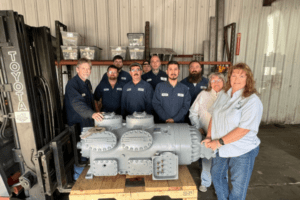As an HVAC/R technician, a comprehensive understanding of commercial refrigeration systems is essential. These systems are vital in various settings, including restaurants, grocery stores, dairies, and warehouses, ensuring perishable goods remain at optimal temperatures. This blog post jumps into the core components and functions of commercial refrigeration systems, emphasizing their significance in maintaining food safety and energy efficiency.
Key Components of Commercial Refrigeration Systems
A commercial refrigeration system comprises several critical components, each playing a pivotal role in its operation:
- Compressor: Often referred to as the system’s pumping heart, the compressor pressurizes the refrigerant, transforming it from a low-pressure gas to a high-pressure gas. This process facilitates heat expulsion as the refrigerant moves through the system.
- Condenser Coils: Typically located at the back or bottom of the unit, condenser coils dissipate heat from the refrigerant into the surrounding environment. Proper maintenance, including regular cleaning, is crucial to prevent dust and debris accumulation, which can impair efficiency.
- Expansion Valve: This component regulates the flow of refrigerant into the evaporator coils, controlling the pressure and temperature to ensure efficient cooling.
- Evaporator Coils: Situated inside the refrigeration unit, evaporator coils absorb heat from the interior, allowing the refrigerant to evaporate and cool the compartment effectively.
- Fan Motors: Both evaporator and condenser fan motors circulate air over the coils, facilitating heat exchange and maintaining consistent temperatures.
The Commercial Refrigeration Cycle Explained
Understanding the refrigeration cycle is fundamental for HVAC/R technicians of levels of experience:
- Compression: The compressor pressurizes the refrigerant gas, raising its temperature and pressure.
- Condensation: The high-pressure gas moves through the condenser coils, releasing heat to the surroundings and condensing into a high-pressure liquid.
- Expansion: The liquid refrigerant passes through the expansion valve, reducing its pressure and temperature and preparing it for the evaporation phase.
- Evaporation: In the evaporator coils, the low-pressure refrigerant absorbs heat from the refrigerator’s interior, evaporating into a gas and completing the cycle.
Importance of Regular Maintenance For Your Commercial Refrigeration System
Regular maintenance is vital to ensure the longevity and efficiency of commercial refrigeration systems. Key maintenance practices include:
- Cleaning Coils: Both condenser and evaporator coils should be cleaned regularly to prevent dust and debris buildup, which can hinder heat exchange and reduce efficiency.
- Inspecting Door Seals: Damaged or worn door gaskets can lead to air leaks, causing the system to work harder and increasing energy consumption. Regular inspection and replacement of faulty gaskets are essential.
- Checking Refrigerant Levels: Proper refrigerant levels are crucial for optimal performance. Low levels can indicate leaks, which should be addressed promptly to prevent system damage.
- Monitoring Fan Motors: Ensuring that fan motors are operating correctly is vital for adequate air circulation over the coils, which is necessary for efficient heat exchange.
Energy Efficiency Considerations For Your Commercial Refrigeration System
Energy efficiency is a significant concern in today’s commercial refrigeration. Technicians can enhance system efficiency by committing to the following:
- Upgrading to High-Efficiency Components: Utilizing ECM (electronically commuted controller) evaporator and condenser fan motors, hot gas anti-sweat heaters, and high-efficiency compressors can significantly reduce energy consumption.
- Implementing Preventative Maintenance Plans: Regular maintenance helps identify and rectify issues before they escalate, ensuring the system operates efficiently and reducing the risk of costly emergency repairs.
By providing regularly scheduled maintenance, you save money by extending the lifespan of your commercial refrigeration system. Adding high-efficiency components to your system also helps save money by reducing your consumption, which will lower your electric bill.
Understanding Your Commercial Refrigeration System is Key
A thorough understanding of commercial refrigeration systems enables HVAC/R technicians to maintain and troubleshoot these units effectively. By focusing on the core components, understanding the refrigeration cycle, and emphasizing regular maintenance and energy efficiency, technicians can ensure these systems operate optimally, safeguarding perishable goods and reducing operational costs.
Top-notch HVAC/R technicians know that without a properly functioning commercial refrigeration compressor, the system will fail. If that happens at an inopportune time for your business, it could cost far more than a new system. This is why they keep a keen eye on this vital component of their system.












